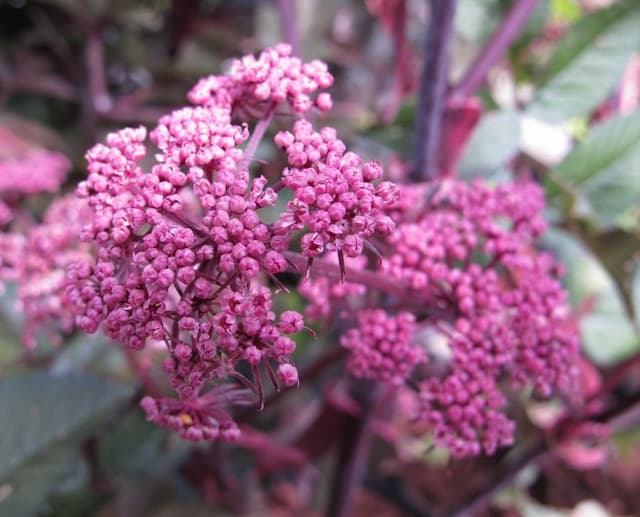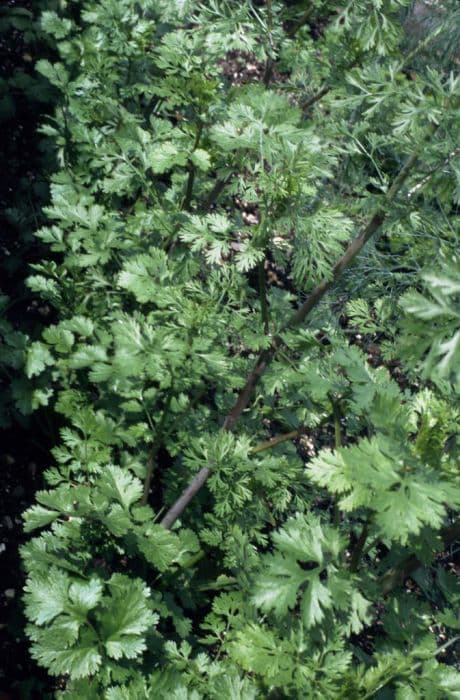Hemlock water-dropwort Oenanthe crocata

ABOUT
Oenanthe crocata, commonly known as hemlock water dropwort, is a perennial plant with a visually striking appearance. It typically grows in damp environments, such as near water bodies or in marshy areas. The hemlock water dropwort has a sturdy, upright stem, which holds aloft umbrella-like clusters of small white flowers, known as umbels, that give it an airy, delicate look despite its robust build. The foliage of hemlock water dropwort is also quite distinctive, being bright green and resembling celery or flat-leaf parsley, with pinnate leaves that are finely divided and toothed; they emerge from the stem in a radial pattern, creating a lush, feathery appearance. The plant's leaves are generally shiny and can add a lively touch of greenery to the waterside settings in which it thrives. Moreover, the roots are fleshy and tuberous, often compared to parsnips or carrots, and can be quite substantial, adding to the plant's tenacity and hardiness. Please note, despite its inviting look, hemlock water dropwort is known to be highly toxic and should be admired from a distance, as all parts of the plant contain dangerous toxins.
About this plant
 Names
NamesFamily
Apiaceae.
Synonyms
Hemlock Water Dropwort, Dead Man's Fingers, Five-Fingered Root, Water Hemlock, Water Dropwort.
Common names
Oenanthe phellandrim, Oenanthe crocata var. aurata, Oenanthe crocata var. robusta, Phellandrium crocatum, Oenanthe crocata var. crocata.
 Toxicity
ToxicityTo humans
Hemlock water dropwort is highly toxic to humans. All parts of the plant contain potent neurotoxins called oenanthotoxins. The toxicity can vary depending on several factors, including the plant's growth stage and the environmental conditions. When ingested, even in small amounts, it can cause symptoms such as nausea, vomiting, abdominal pain, and diarrhea. Severe poisoning can lead to muscle paralysis, convulsions, and can result in respiratory failure. Due to its high toxicity, ingestion of hemlock water dropwort often has serious consequences and can be fatal if not treated promptly.
To pets
Hemlock water dropwort is also highly toxic to pets. Similar to its effect on humans, all parts of the plant contain dangerous neurotoxins that can cause severe and potentially lethal symptoms. In pets, the ingestion of this plant can lead to drooling, abdominal pain, vomiting, diarrhea, tremors, seizures, and muscle paralysis. These symptoms can progress rapidly, and without immediate veterinary care, poisoning from hemlock water dropwort can be fatal to pets.
 Characteristics
CharacteristicsLife cycle
Perennials
Foliage type
Deciduous
Color of leaves
Green
Flower color
White
Height
5 feet [1.5 meters]
Spread
2 feet [0.6 meters]
Plant type
Herb
Hardiness zones
6
Native area
Europe
Benefits
 General Benefits
General Benefits- Water Purification: Oenanthe crocata, commonly known as water dropwort, is often found in water systems where its presence can help reduce nutrient levels, thus limiting algal blooms.
- Ecological Importance: Water dropwort provides habitat and feeding grounds for various aquatic organisms, serving as a vital part of the ecosystem.
- Aesthetic Value: With its attractive foliage and flowers, water dropwort adds natural beauty to wetlands and ponds.
- Erosion Control: The root system of the water dropwort helps stabilize soil and prevent erosion along riverbanks and wetland areas.
- Support for Biodiversity: It offers food and shelter to a range of species, including insects and amphibians, contributing to a diverse and balanced ecosystem.
- Food Source: The plant is sometimes used as a food source for livestock, though caution is advised due to its toxicity when not properly managed or identified.
- Traditional Uses: In some cultures, parts of the plant have been used for food or traditional crafts, though significant care must be taken due to its toxic nature.
 Medical Properties
Medical PropertiesThis plant is not used for medical purposes.
 Air-purifying Qualities
Air-purifying QualitiesThis plant is not specifically known for air purifying qualities.
 Other Uses
Other Uses- Oenanthe crocata, commonly known as hemlock water-dropwort, has been historically used as a poison due to its highly toxic components; it was dropped into wells or water supplies during times of conflict to contaminate the enemy's water resources.
- In folklore, hemlock water-dropwort was sometimes associated with witchcraft, where it was believed to be used in concoctions and spells.
- The plant’s stems have been used in traditional whistles and pipes, specifically by shepherds, due to their hollow nature when dried.
- Because of its toxicity, hemlock water-dropwort was employed as a means to catch fish by stupefying them, making them easier to collect.
- In ancient times, it was reported to be used for executions, where the condemned would be forced to consume the plant.
- The roots of hemlock water-dropwort have been carved into talismans and amulets, historically believed by some to ward off evil spirits when worn or hung in the home.
- The striking appearance of hemlock water-dropwort when in bloom has occasionally been used as a dramatic addition to floral arrangements, albeit with great caution due to its poisonous nature.
- Due to its vigorous growth, the plant has sometimes been used as a natural barrier or to stabilize soil in areas prone to erosion, though this use is risky and generally discouraged.
- During medieval times, extracts from hemlock water-dropwort were believed to be part of the potion ingredients that were said to induce visions or trances.
- Some beekeepers consider hemlock water-dropwort a valuable yet risky plant as it attracts pollinators; however, it is vital to ensure that honey produced from these flowers is not toxic.
Interesting Facts
 Feng Shui
Feng ShuiThe Hemlock Water Dropwort is not used in Feng Shui practice.
 Zodiac Sign Compitability
Zodiac Sign CompitabilityThe Hemlock Water Dropwort is not used in astrology practice.
 Plant Symbolism
Plant Symbolism- Hemlock Water Dropwort (Oenanthe crocata)
- Danger: The plant is highly toxic and its presence often symbolizes danger or a hidden threat.
- Deception: Hemlock Water Dropwort resembles some edible plants, which can symbolize the idea of deception or things not being as they seem.
- Death: Due to its potent toxicity, it's often associated with death and can represent a warning of fatal consequences.
- Illusion: As the plant can be mistaken for harmless flora, it may symbolize illusion or the subjective nature of perception.
 Water
WaterHemlock water dropwort should be watered moderately, ensuring the soil remains moist but not waterlogged. During the growing season, typically spring and summer, water the plant once or twice a week, depending on weather conditions. Each watering session could range from 16 to 32 ounces for potted plants, adjusting the amount to ensure the soil is moist. For garden plants, about 1-2 gallons per week might be necessary, depending on the size of the plant and the soil's ability to retain moisture. It's essential to reduce watering frequency in the dormant season, fall and winter, to prevent root rot.
 Light
LightHemlock water dropwort thrives best in full sun to partial shade. It should be placed in a spot where it can receive at least six hours of direct sunlight daily. However, in regions with very intense sun, some afternoon shade is beneficial to prevent leaf scorch.
 Temperature
TemperatureHemlock water dropwort prefers temperatures between 60 to 75 degrees Fahrenheit. It can tolerate a minimum temperature of around 50 degrees Fahrenheit and a maximum of about 80 degrees Fahrenheit. For optimal growth, keep the plant within this temperature range and protect it from extreme temperature fluctuations.
 Pruning
PruningPrune hemlock water dropwort to maintain its shape and remove any dead or diseased foliage. It's best to prune in the late winter or early spring before new growth begins. Pruning frequency should be as needed, focusing on shaping the plant and promoting healthy growth.
 Cleaning
CleaningAs needed
 Soil
SoilHemlock water dropwort (Oenanthe crocata) thrives best in a soil mix that is consistently moist, as it naturally grows in wet environments such as marshes and stream banks. The ideal soil would be a mix incorporating rich loam and organic matter to retain moisture, possibly with some sandy or peaty soil to improve drainage slightly. The pH for this plant should be neutral to slightly acidic, around pH 6.0 to 7.0.
 Repotting
RepottingHemlock water dropwort should be repotted with caution as necessary since it prefers consistent conditions, likely every 2-3 years or when it outgrows its current pot. Utilize a pot that is just slightly larger as it enjoys being slightly root-bound.
 Humidity & Misting
Humidity & MistingHemlock water dropwort requires high humidity levels to mimic its natural wetland habitat. Aim for a humidity level above 60% to ensure healthy growth.
 Suitable locations
Suitable locationsIndoor
Ensure good light and moist soil to grow Hemlock water dropwort.
Outdoor
Plant in a shaded, damp area and keep soil consistently wet.
Hardiness zone
6-9 USDA
 Life cycle
Life cycleThe common name of Oenanthe crocata is water dropwort. Its life begins with seed germination, typically occurring in moist or aquatic environments where conditions are suitable for growth. Following germination, the seedling emerges and develops a rosette of basal leaves during the vegetative stage. After a period of growth, the plant enters the reproductive stage, characterized by the formation of tall, hollow stems and umbrella-like clusters of small white flowers, which are typically produced in summer. The flowers are pollinated by insects, leading to the production of fruits called schizocarps that eventually split open to release seeds. The plant completes its life cycle when these seeds disperse, often by water, to begin the cycle anew.
 Propogation
PropogationPropogation time
Spring-Early Summer
The most popular method of propagating Hemlock Water Dropwort, known scientifically as Oenanthe crocata, is through division. This method is typically carried out in the spring or early fall. To propagate by division, carefully lift the plant from the ground and use a sharp knife or spade to separate the clump into smaller sections, ensuring that each section has a part of the root system. Replant the divisions immediately at the same depth they were growing previously, spacing them about 12 to 18 inches (approximately 30 to 45 centimeters) apart. Water the new plants thoroughly to help establish them. It is crucial to exercise caution when handling Hemlock Water Dropwort, as all parts of the plant are highly toxic.








